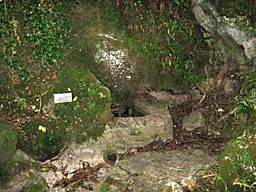Stoke Lane Slocker facts for kids
Quick facts for kids Stoke Lane Slocker |
|
|---|---|

Entrance (when dry)
|
|
| Location | Stoke St Michael |
| Depth | 30m |
| Length | 2.18km |
| Geology | Limestone |
| Hazards | Weils Disease |
| Cave survey |
|
Stoke Lane Slocker is an amazing cave found near Stoke St Michael in the Mendip Hills of Somerset, England. It's carved into a type of rock called Carboniferous Limestone.
This cave is quite long, stretching for about 2.18 kilometers (that's over 1.3 miles!). It also goes pretty deep, reaching down 30 meters (about 98 feet) underground.
The cave used to be called Stoke Lane Swallet. But now, people prefer to use its local name, "Slocker." The word "Slocker" might come from an old word meaning "to entice" or "to lure." It could also be related to a Gaelic word for a swallow hole, which is a place where a stream disappears underground.
Contents
Exploring Stoke Lane Slocker's History
People have been exploring Stoke Lane Slocker for a long time.
Early Discoveries
The first person known to explore this cave in recent times was Mr. Marshall, around 1905. He was from a nearby village called Stratton-on-the-Fosse.
Major Explorations Begin
Big explorations and mapping of the cave really took off in 1947. This is when explorers reached "Sump 1." A sump is an underwater passage in a cave that divers must swim through.
Later that same year, divers managed to get past Sump 1. This led them to discover the beautiful "Stoke Two" section, which has many decorated chambers.
Pushing Deeper into the Cave
Over the 1960s, brave explorers pushed even further. They managed to pass Sumps 2 through 7.
In 1971, the "Bailey-Ward Series" of chambers was found. These are more amazing parts of the cave system.
Inside Stoke Lane Slocker Cave
Stoke Lane Slocker is full of interesting features, from narrow passages to large, decorated rooms.
The Entrance and Stoke One
The cave's entrance is usually underwater. It's located near an old quarry called Stoke Lane Quarry. An underground stream flows out of the cave here, feeding a water source known as St Dunstan's Well.
Because of its special features, the cave has been named a Site of Special Scientific Interest. This means it's protected for its natural importance.
The first part of the cave, from the entrance to Sump 1, is called "Stoke One." It mostly has low, narrow passages.
The Bailey-Ward Series
Beyond Stoke One, you find the "Bailey-Ward Series" of chambers. One part of this series is called Bernard's Rift. It's about 20 meters (65 feet) high!
Inside Bernard's Rift, you can see clear crystal pools. These pools contain calcite-covered goniatite snail shells. You might also spot "cave pearls," which are small, round formations that look like pearls.
Stoke Two and its Wonders
The area between Sump 1 and Sump 2 is known as "Stoke Two." This section is famous for its highly decorated chambers.
- Upper Grotto
- Traverse Grotto
- The Throne Room: This room has a huge stalactite boss (a type of cave formation hanging from the ceiling) named The King. It's about 3 meters (10 feet) tall! There's also another stalactite, 2 meters (6.5 feet) high, called The Queen, named after Queen Victoria.
- Princess Grotto: This grotto once had spectacular formations. Sadly, some of them have been damaged since the cave was first explored.
- Bone Chamber: This chamber isn't decorated, but when it was found, it contained human and animal bones, along with ash and charcoal.
Beyond Sump Two
After the second sump, the cave continues with a long passage. This passage contains six more sumps, making it a challenging journey for experienced cave divers.
Cave Sumps and Challenges
Sumps are underwater sections of a cave that cavers must dive through. Here's a look at some of the sumps in Stoke Lane Slocker:
| Sump Number | Dive Length | Notes |
|---|---|---|
| Sump 1 | 18 inches (45 cm) | Can be free-dived (no special equipment needed) |
| Sump 2 | 10 meters (33 feet) | Only for fully equipped divers |
| Sump 3 | Unknown | Can be avoided by going around it |
| Sump 4 | 20 meters (65 feet) | Only for fully equipped divers |
| Sump 5 | Unknown | Can be avoided by going around it |
| Sump 6 | 12 meters (39 feet) | |
| Sump 7 | 15 meters (49 feet) | Very narrow and tight |
| Sump 8 | Unknown | Blocked by boulders, cannot be passed |
Important Safety Information
Caves can be exciting to explore, but it's very important to be safe. In Stoke Lane Slocker, there have been reports of people getting sick with a condition called Weils Disease. This illness can be caught from dirty water, especially if it contains animal waste.
Always be careful when exploring caves, especially if there's water. It's best to go with experienced cavers and follow all safety guidelines to protect yourself.

